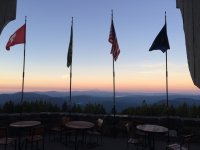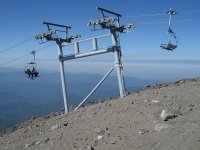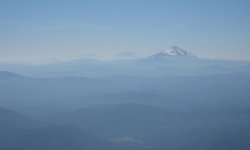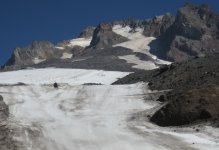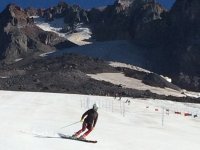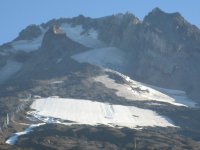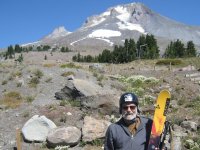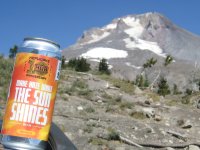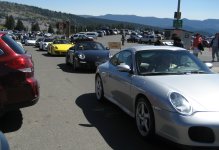tseeb
Well-known member
I knew a week or so ago that I would be driving within 6 miles of Timberline between family event in Vancouver, WA and Portland, OR and personal business in Central OR so last Friday I did some tuning and waxing on a pair of skis and brought them with me along with my mountain bike. I didn't have much hope for conditions as I saw a lot of early PM temps in high 60s reported by Timberline last week. I was very lucky to ski today after one of the coolest overnight temps all summer vs. yesterday when it was warmer, rained and lifts closed @10:30 AM due to poor visibility. Current hours (until Labor Day) are 7:30-1:30 with Magic Mile open 30 min. later for downloading.
After attending service for her sister and brother-in-law who both passed away in the last 20 months, I dropped my Mother at PDX on Mon. for her 6 pm flight home. I got to the Skyway bar between Zigzag and Rhododendron before live music started outside at 7. I spent night in my SUV near rest area at Government Camp and drove up to Timberline about 6:30. I had a couple of cups of coffee in lobby (for lodge guests only), used the facilities and bought $49 day ticket in Day Lodge.
 It's a long walk from parking below lodge to Magic Mile lift where you have to carry your skis and poles onto lift. Then it's a couple of minutes downhill walk to 1500+' vertical Palmer lift that I rode at least 23 times. Most of my runs were to mid-station, about 750 vertical with 600 of that on smooth snowfields. I also skied to the base of Palmer 5 times, once via late opening terrain park that had good snow but a long walk to base of lift. You could easily ski to mid-station loading although ramp was ugly. Skiing to bottom of Palmer required removing skis for a 2-3 min walk across a small gully, then putting skis on on carpet at top of ramp before loading.
It's a long walk from parking below lodge to Magic Mile lift where you have to carry your skis and poles onto lift. Then it's a couple of minutes downhill walk to 1500+' vertical Palmer lift that I rode at least 23 times. Most of my runs were to mid-station, about 750 vertical with 600 of that on smooth snowfields. I also skied to the base of Palmer 5 times, once via late opening terrain park that had good snow but a long walk to base of lift. You could easily ski to mid-station loading although ramp was ugly. Skiing to bottom of Palmer required removing skis for a 2-3 min walk across a small gully, then putting skis on on carpet at top of ramp before loading.


I was at top of Palmer about 8 AM and found firm, but very skiable snow for the first hour. Thermometer inside unloading station showed ~40 all morning. They told me the lanes on skiers right, closest to lift, were for public so I stayed over that way for a while. It is so late in the season that camps were only using 1-2 lanes so there were about 10 lanes open to public and when campers were reviewing video after taking down gates, most of the 1000'? wide snowfield was available. By 10 AM there was hero corn across most of the snowfields until almost the end above exit road where it was a little firmer as it narrowed and was heavily salted.

The lower 1/2 of Palmer was 10-20' wide and had some dirty snow and chokes that deteriorated quickly. I quit a little before noon with 21K. I thought about another run or two, but with to hike to the top of the Mile to download and then past lodge to my SUV, I was glad I quit when I did. Will post more pictures from camera when I get home. Much smokier to W of Hood than to E even though they were burning some fields near Madras.
After attending service for her sister and brother-in-law who both passed away in the last 20 months, I dropped my Mother at PDX on Mon. for her 6 pm flight home. I got to the Skyway bar between Zigzag and Rhododendron before live music started outside at 7. I spent night in my SUV near rest area at Government Camp and drove up to Timberline about 6:30. I had a couple of cups of coffee in lobby (for lodge guests only), used the facilities and bought $49 day ticket in Day Lodge.
I was at top of Palmer about 8 AM and found firm, but very skiable snow for the first hour. Thermometer inside unloading station showed ~40 all morning. They told me the lanes on skiers right, closest to lift, were for public so I stayed over that way for a while. It is so late in the season that camps were only using 1-2 lanes so there were about 10 lanes open to public and when campers were reviewing video after taking down gates, most of the 1000'? wide snowfield was available. By 10 AM there was hero corn across most of the snowfields until almost the end above exit road where it was a little firmer as it narrowed and was heavily salted.
The lower 1/2 of Palmer was 10-20' wide and had some dirty snow and chokes that deteriorated quickly. I quit a little before noon with 21K. I thought about another run or two, but with to hike to the top of the Mile to download and then past lodge to my SUV, I was glad I quit when I did. Will post more pictures from camera when I get home. Much smokier to W of Hood than to E even though they were burning some fields near Madras.
Last edited by a moderator:
